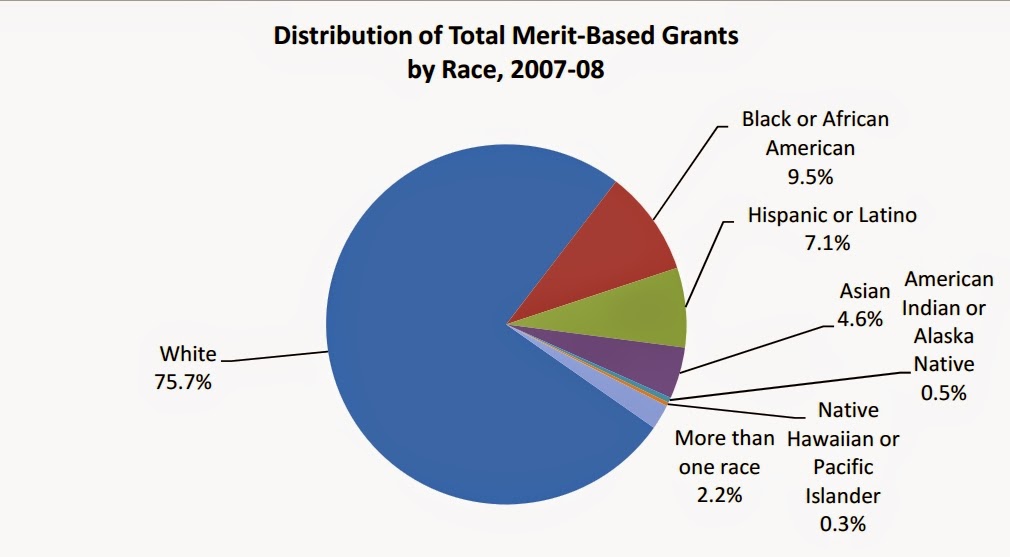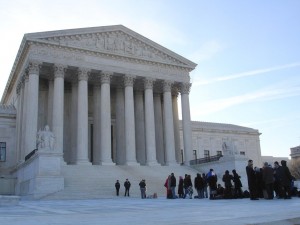(This blog was originally posted on David Shih’s personal blog and is reposted here with his permission).
I think it’s me. I have a BA from the University of Texas and a Ph.D. from the University of Michigan. Both universities just happen to be involved with the landmark affirmative action cases of our generation, Grutter v. Bollinger (2003), Gratz v. Bollinger (2003), and Fisher v. University of Texas (2013). Coincidence? Michigan and Texas put up staunch, largely-successful defenses of their affirmative action admissions policies. But the issue remains fraught, earlier this month bringing a couple of noteworthy developments. Abigail Fisher filed an appeal to the Supreme Court, keeping alive her lawsuit against the University of Texas. And the actor Vince Vaughn decided to weigh in on the issue. In an interview appearing in Playboy, Vaughn explains why he is not a “fan” of affirmative action:
But then you’re evaluating someone based on race, which is racism. Rights don’t come to you because you’re a man or a woman or African American or European or Jewish. And I certainly don’t think the federal government should be in the business of deciding things or handing out money based on factors like these.
I wouldn’t be an English professor today were it not for affirmative action. This blog entry won’t convince Vaughn or anyone else against affirmative action to change their minds–affirmative action is that kind of issue–but even those in favor of it may not know everything they need to about its history and nature.
In 1987, the summer before I started college at the University of Texas, I was awarded the Virginia and Ernest Cockrell, Jr. Scholarship in Engineering. I didn’t apply for this scholarship, so it must have been one of the many merit-based scholarships I was eligible for by checking a box on my application. I was a strong high school student and did well on my SAT, factors that probably contributed more than anything to my earning the scholarship. Months before taking the SAT, I convinced my dad to spring for a computerized study course for our IBM PC. It cost $200. For weeks, I parked myself in front of the PC and took dozens of sample tests based on actual SATs. When it was time to take the real deal, I was more than ready. The UT scholarship awarded $2,000 a year, and it was renewable provided I kept my grades up. (I didn’t.) As far as I know, my receiving it had nothing to do with affirmative action and everything to do with high school GPA and SAT score.
The reason I chose Michigan for my doctoral institution was because of an affirmative-action based opportunity called the Rackham Merit Fellowship for Historically-Underrepresented Minorities (it’s not called that anymore, but maybe it should be). There just weren’t that many Asian Americans wanting to study English language and literature. I’m much prouder of the Michigan fellowship than I am of the Texas scholarship, largely because of what I had to do to get it. I had to demonstrate to the admissions committee that Asian American literature belonged within English studies. My fellowship money had everything to do with my racial identity because someone believed that the consciousness and experiences of an Asian American mattered in the research and teaching of Asian American literature. I’m sure that some would say that the “special treatment” is not only unfair to white people but also unfair to me. But they’re wrong about this and more, and I’ll tell you why.
Rackham Merit Fellowship for Historically-Underrepresented Minorities (it’s not called that anymore, but maybe it should be). There just weren’t that many Asian Americans wanting to study English language and literature. I’m much prouder of the Michigan fellowship than I am of the Texas scholarship, largely because of what I had to do to get it. I had to demonstrate to the admissions committee that Asian American literature belonged within English studies. My fellowship money had everything to do with my racial identity because someone believed that the consciousness and experiences of an Asian American mattered in the research and teaching of Asian American literature. I’m sure that some would say that the “special treatment” is not only unfair to white people but also unfair to me. But they’re wrong about this and more, and I’ll tell you why.
Myth #1: Affirmative Action Beneficiaries Are Unqualified
Considering the race of students among other qualities doesn’t mean that unqualified students are admitted. The lack of qualification is one of the biggest myths of affirmative action. Nobody should get a job or place in college that they aren’t qualified for; you are either qualified or not. (UT’s president is under fire at the moment for some off-the-books affirmative action for unqualified students.) Yet people of color bear the burden of suspicion when it comes to qualification. Abigail Fisher, who sued my alma mater for discriminating against her because she is white, is a good example of this mentality. A ProPublica story reported that in the year of her application, 47 students were provisionally admitted to the University of Texas with GPAs and SAT scores lower than Fisher’s; 42 of the students are white. As well, 168 black and Latino students with higher GPAs and SAT scores than Fisher were denied admission. Why didn’t Fisher target the white students? Were all of their qualities accessible to her as a young, middle-class white woman? Why didn’t she target the low-income students, or those raised in single-parent households, also experiences that you cannot “earn”? Why ignore white men whose gendered experiences may have compensated for lower scores? The failure here is the inability to imagine qualifications beyond AP credits and test-taking proficiency.
Myth #2: Affirmative Action Leads to a Poorer Learning Experience
In allowing the University of Michigan to continue using race as a factor in admissions (until a 2006 referendum ended all affirmative action in the state), the Supreme Court admitted that diversity is a “compelling interest” for student learning. You’d be surprised how many students and colleagues don’t give this reason when asked why we should have affirmative action in college admissions. Instead, they sometimes say that “it is the right thing to do” given the history of institutional racism in the US and in higher education. Certainly, this is a consideration. But an equally valid response is that affirmative action makes everyone in the classroom smarter. As a student wrangling with social issues in your English, sociology, nursing, marketing, and journalism classes, wouldn’t you want as many different perspectives as possible on those issues? Wouldn’t everyone benefit from hearing a black man’s perspective on the death penalty or a Hmong woman’s perspective on gerontology? Colleges and universities do not implement affirmative action policies out of regard for social justice only; they have them because they are ethically-committed to providing the richest educational experience for all of their students.
Myth #3: White Students Lose Out to Minorities for Scholarships
Even then, institutions don’t necessarily make it easier for students of color to attend even after they are admitted. Another enduring myth of affirmative action is that students of color get more than their share of scholarship and grant monies. However, the opposite is true. Mark Kantrowitz of Edvisiors.com released an influential report in 2011, “The Distribution of Grants and Scholarships by Race,” which found that while white students made up 62% of all college undergraduates, they received 69% of all institutional grant funding (and 65% of all private scholarship monies). I recently contacted Kantrowitz, and he told me that the figures are basically the same now. When it comes to merit-based institutional grants like my engineering scholarship from Texas, white students claim almost 76% of the funding. In almost all of the metrics in Kantrowitz’s study, save need-based grants, white students garnered more than their share of the available funding.
 Myth #4: Affirmative Action Benefits Only People of Color
Myth #4: Affirmative Action Benefits Only People of Color
I ask my students what kind of person comes to mind when they hear the words “affirmative action.” That image should be of a white woman, if we’re talking about the group that has been the primary beneficiary of affirmative action since the 1960s. The title of Sally Kohn’s 2013 article for Time doesn’t leave much room for equivocation: “Affirmative Action Has Helped White Women More Than Anyone.” Using examples from the public and private sector, Kohn shows that affirmative action has advanced the careers of white women more than those of people of color. From 1985 to 2000, the median wage gain of white women outpaced that of white men and black men and women. Not only do white women benefit from affirmative action, but so do their white husbands and white children. The 2010 Census revealed that 97% of the people who checked “White” as their race did not check another box. This means that 97% of those who believe that they have white ancestors believe that they have only white ancestors. In 2010, Pew found that white women marry outside of their race at a 9% rate, the lowest of any racial group. For generations, then, most affirmative action resources have been returned to white people, many living in predominantly white communities. Because of these relationships, the Atlanta Blackstar went as far as to say that the group that benefits the most from affirmative action after white women is white men.
Myth #5: Affirmative Action Hurts People of Color in the Long Run
Those spouting this myth purport to advocate for people of color and to know what is best for them. Granted, people of all races do this. But I’ve heard it most often from white people who say that affirmative action places people of color into circumstances beyond their abilities or that it fosters a culture of dependency. What’s amusing here is that the group with more power purports to know what is best for the group with less power. (I ask those who think that ending affirmative action will help people of color what else they are doing to interrupt racism and live antiracist lives.) A recent survey asked 1,000 participants to respond to this statement: “Affirmative action programs are still needed to counteract the effects of discrimination against minorities, and are a good idea as long as there are no rigid quotas.” 71% of black Americans strongly agreed with this statement, while only 20% of white Americans did. I will go out on a limb here and say that these black people know what is best for them. I wonder if the other 80% of white Americans acknowledge that white people tend to get the jobs they have because of their associations with other white people–friends, friends of friends, family members, frat brothers, et al. However, this kind of advantage is not seen as special treatment deleterious to the recipient. It is, simply, smart networking. A recent study showed that white people have social networks that are 91% white, with 75% of white people reporting zero minority presence in their social networks.
Myth #6: Affirmative Action Is Just Reverse Racism
This argument against affirmative action never fails to irk me with its facile use of the word “racism.” All it takes is a little critical thinking to reveal it as a false analogy. When James Meredith was trying to attend the University of Mississippi, what was the rationale of the school for denying him admission and of the Governor going through the courts to keep him out? We might fairly call the rationale white supremacy. When the University of Texas takes the race of a student into consideration for admission, what is the rationale? Is it black supremacy? Latino supremacy? American Indian supremacy? Or is it a more ethical rationale, one aware of the historical impacts of institutional racism and sexism? Moreover, modern-day affirmative action in the workplace does not take the form of “preferential treatment” for white women or people of color. Rather, the goal of most workplace affirmative action efforts is to diversify applicant pools with expanded outreach and recruitment strategies. Even with greater diversity within applicant pools, “aversive racism” can intervene so that white applicants still come away with the job. Far from being racist, the rationale for affirmative action is, in fact, antiracist. According to law professor Cheryl Harris, affirmative action has been the only institutional intervention against the entitlements historically derived from white identity.
I could go on, but the reality is that none of these points will sway those like Vaughn who agree with Chief Justice John Roberts, who said that “T href=”http://www.theatlantic.com/politics/archive/2014/10/on-race-and-voter-id-john-roberts-wants-it-both-ways/381868/” target=”_blank”>he way to stop discriminating on the basis of race, is to stop discriminating on the basis of race.” Such a colorblind approach operates out of the belief that affirmative action has outlived its necessity, this despite the fact that black unemployment rates have been double that of white people for decades now. It refuses to read the impacts of centuries of institutionalized genocide, slavery, exclusion, and segregation into present-day circumstances and relationships. It misses how, since the 17th century, the allocation of state resources on the basis of race is affirmative action for white people: “freedom dues” for indentured servants, the Homestead Act, the Social Security Act, the GI Bill of Rights, FHA-recommended interest rates, and more. The reach of policies such as the GI Bill extends even into the lives of my traditional-aged college students. “A family’s net worth is not simply the finish line,” says sociologist Dalton Conley. “It’s also the starting point for the next generation.”
href=”http://www.theatlantic.com/politics/archive/2014/10/on-race-and-voter-id-john-roberts-wants-it-both-ways/381868/” target=”_blank”>he way to stop discriminating on the basis of race, is to stop discriminating on the basis of race.” Such a colorblind approach operates out of the belief that affirmative action has outlived its necessity, this despite the fact that black unemployment rates have been double that of white people for decades now. It refuses to read the impacts of centuries of institutionalized genocide, slavery, exclusion, and segregation into present-day circumstances and relationships. It misses how, since the 17th century, the allocation of state resources on the basis of race is affirmative action for white people: “freedom dues” for indentured servants, the Homestead Act, the Social Security Act, the GI Bill of Rights, FHA-recommended interest rates, and more. The reach of policies such as the GI Bill extends even into the lives of my traditional-aged college students. “A family’s net worth is not simply the finish line,” says sociologist Dalton Conley. “It’s also the starting point for the next generation.”
Growing up in affluent Lake Forest, Illinois, Vince Vaughn benefited from the accomplishments of his parents, his mother an elite, Bloomberg-recognized money manager. Perhaps affirmative action was a guiding hand in her career, who knows? Vaughn’s example reminds me of a famous quotation from University of Texas arch-enemy Barry Switzer (one so good that others adopted it for political purposes): “Some people are born on third base and go through life thinking they hit a triple.”
On second thought, it’s not me. It’s Vince Vaughn and people like him. You’re so money, and you don’t even know it, Vince.
(David Shih is an associate professor of English at the University of Wisconsin-Eau Claire).


